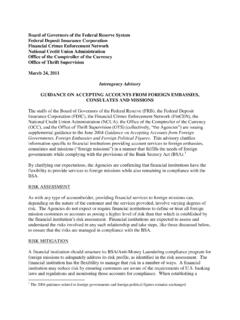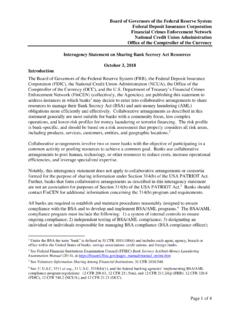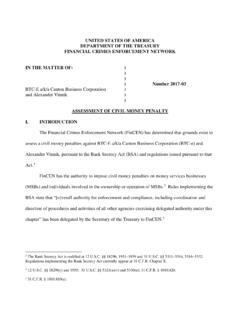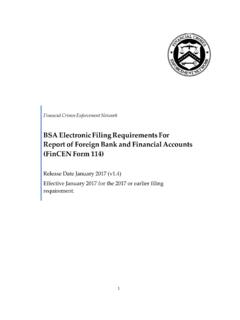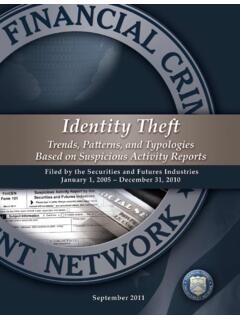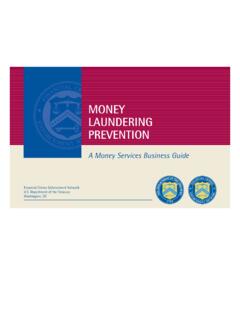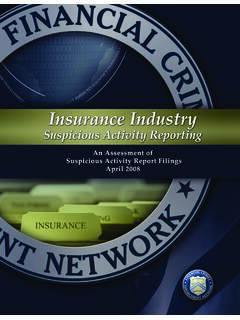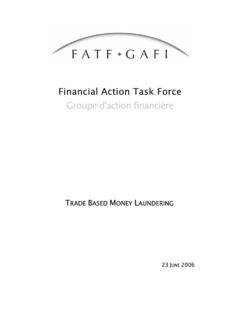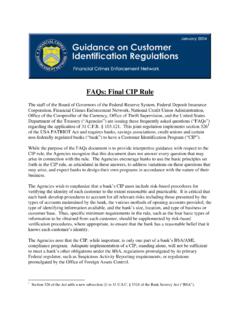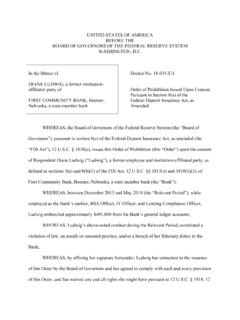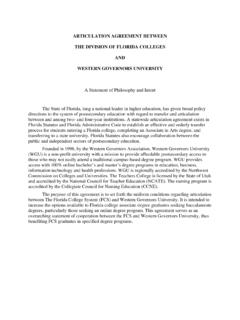Transcription of Joint Statement on Innovative Efforts to Combat Money ...
1 board of Governors of the Federal Reserve System Federal Deposit Insurance Corporation Financial Crimes Enforcement Network National Credit Union Administration Office of the Comptroller of the Currency Joint Statement on Innovative Efforts to Combat Money Laundering and Terrorist Financing December 3, 2018 The board of Governors of the Federal Reserve System, the Federal Deposit Insurance Corporation, the Financial Crimes Enforcement Network (FinCEN), the National Credit Union Administration, and the Office of the Comptroller of the Currency (collectively, the Agencies) are issuing this Joint Statement to encourage banks11 Under the Bank Secrecy Act, the term bank is defined in 31 C FR (d) and includes each agent, agency, branch, or office within the United States of banks, savings associations, credit unions, and foreign banks.
2 To consider, evaluate, and, where appropriate, responsibly implement Innovative approaches to meet their Bank Secrecy Act/anti- Money laundering (BSA/AML) compliance obligations, in order to further strengthen the financial system against illicit financial activity. The Agencies recognize that private sector innovation, including new ways of using existing tools or adopting new technologies, can help banks identify and report Money laundering, terrorist financing, and other illicit financial activity by enhancing the effectiveness and efficiency of banks BSA/AML compliance programs. To assist banks in this effort, the Agencies are committed to continued engagement with the private sector and other interested parties.
3 The Agencies will not penalize or criticize banks that maintain effective BSA/AML compliance programs commensurate with their risk profiles but choose not to pursue Innovative approaches. While banks are expected to maintain effective BSA/AML compliance programs, the Agencies will not advocate a particular method or technology for banks to comply with BSA/AML requirements. Innovative Approaches to Combat Money Laundering, Terrorist Financing, and Other Illicit Financial Activity Innovation has the potential to augment aspects of banks BSA/AML compliance programs, such as risk identification, transaction monitoring, and suspicious activity reporting. Some banks are becoming increasingly sophisticated in their approaches to identifying suspicious activity, commensurate with their risk profiles, for example, by building or enhancing Innovative internal financial intelligence units devoted to identifying complex and strategic illicit finance 1 | Page vulnerabilities and threats.
4 Some banks are also experimenting with artificial intelligence and digital identity technologies applicable to their BSA/AML compliance programs. These innovations and technologies can strengthen BSA/AML compliance approaches, as well as enhance transaction monitoring systems. The Agencies welcome these types of Innovative approaches to further Efforts to protect the financial system against illicit financial activity. In addition, these types of Innovative approaches can maximize utilization of banks BSA/AML compliance resources. Pilot programs undertaken by banks, in conjunction with existing BSA/AML processes, are an important means of testing and validating the effectiveness of Innovative approaches. While the Agencies may provide feedback, pilot programs in and of themselves should not subject banks to supervisory criticism even if the pilot programs ultimately prove unsuccessful.
5 Likewise, pilot programs that expose gaps in a BSA/AML compliance program will not necessarily result in supervisory action with respect to that program. For example, when banks test or implement artificial intelligence-based transaction monitoring systems and identify suspicious activity that would not otherwise have been identified under existing processes, the Agencies will not automatically assume that the banks existing processes are deficient. In these instances, the Agencies will assess the adequacy of banks existing suspicious activity monitoring processes independent of the results of the pilot program. Further, the implementation of Innovative approaches in banks BSA/AML compliance programs will not result in additional regulatory expectations.
6 At the same time, compliance with the BSA and its regulations is critically important in protecting the financial system, and banks that fail to comply with BSA/AML requirements expose the financial system to abuse by illicit actors. Accordingly, banks must continue to meet their BSA/AML compliance obligations, as well as ensure the ongoing safety and soundness of the bank, when developing pilot programs and other Innovative approaches. Bank management should prudently evaluate whether, and at what point, Innovative approaches may be considered sufficiently developed to replace or augment existing BSA/AML processes. In making these evaluations, bank management should also consider and address other factors including, but not limited to, information security issues, third-party risk management, and compliance with other applicable laws and regulations, such as those related to customer notifications and privacy.
7 Bank management should also discuss their evaluations with the bank s respective regulators. Commitment to Continued Private Sector Engagement The Agencies are open to engaging with bank management to discuss pilot programs for Innovative BSA/AML approaches. As banks pursue Innovative change, early engagement can promote a better understanding of these approaches by the Agencies, as well as provide a means to discuss expectations regarding compliance and risk management. In addition, the Agencies will clarify supervisory expectations, as appropriate and necessary. The Agencies will continue to monitor industry developments and encourage responsible Innovative approaches in BSA/AML compliance programs that help protect the financial system against illicit financial activity.
8 To this end, the Agencies are exploring additional methods to encourage innovation, including through FinCEN s Bank Secrecy Act Advisory Group. Also, to 2 | Page the extent necessary and appropriate, FinCEN will consider requests for exceptive relief under 31 CFR to facilitate the testing and potential use of new technologies and other innovations, provided that banks maintain the overall effectiveness of their BSA/AML compliance programs. FinCEN is launching an innovation initiative to foster a better understanding of the opportunities and challenges of BSA/AML-related innovation in the financial services sector. As part of this initiative, FinCEN will engage in outreach Efforts that include dedicated times for financial institutions, technology providers, and other firms involved in financial services innovations to discuss the implications of their products and services, and their future applications or next steps.
9 Similarly, each of the other Agencies has, or will establish, projects or offices that will work to support the implementation of responsible innovation and new technology in the financial system. While bank management should continue to follow existing protocols for communication with their respective regulators, these projects or offices may also serve as central points of contact to facilitate communication related to innovation and new technology. In addition, they are intended to enhance the other Agencies ability to respond to innovation and new technology, understand the related risks, and encourage discussion of regulatory principles, processes, and expectations. The Agencies also welcome industry s feedback on how the Agencies can best support Innovative Efforts through explanations of, or updates to, supervisory processes, regulations, and guidance.
10 Those wishing to share such feedback in writing may do so by sending their submission electronically to FinCEN at 3 | Page
